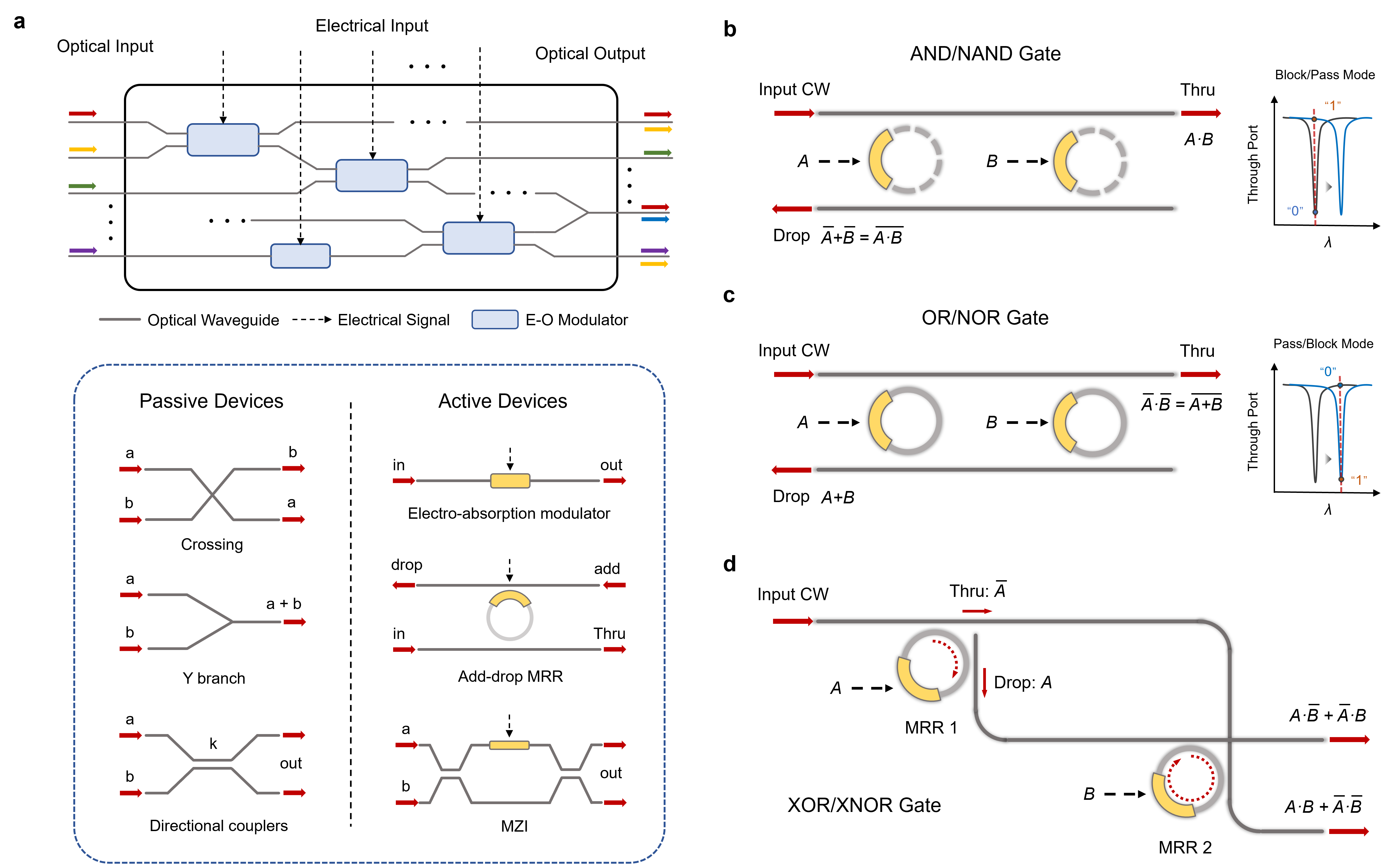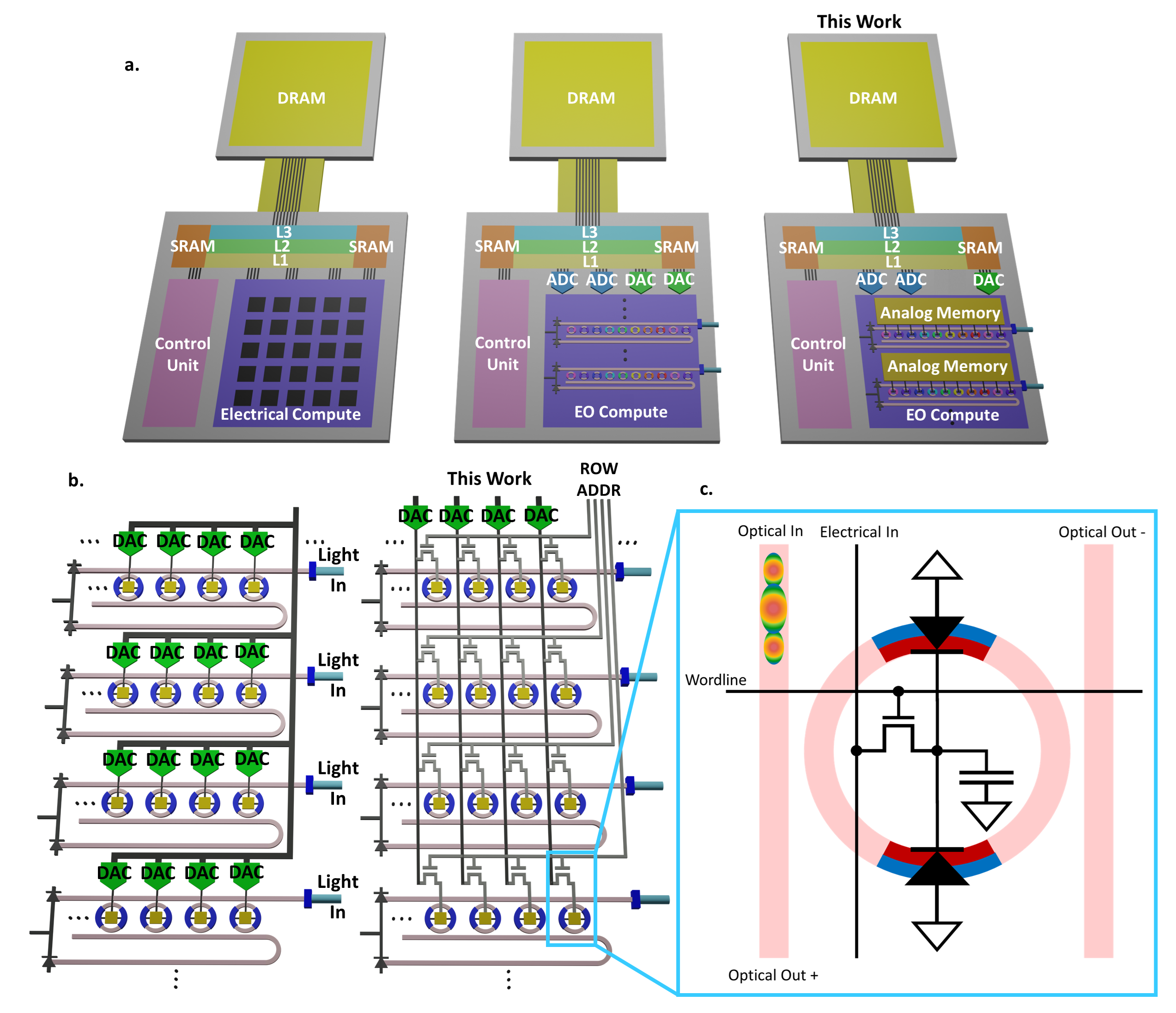Photonic-Electronic Integrated Circuits for High-Performance Computing and AI Accelerators

0

Sign in to get full access
Overview
- This paper explores the development of photonic-electronic integrated circuits (PEICs) for high-performance computing and AI acceleration.
- PEICs combine optical and electronic components on a single chip, enabling faster and more energy-efficient data processing compared to traditional electronic-only systems.
- The authors survey the state of optical digital computing on photonic integrated circuits (PICs), including optical neural networks, iterative matrix inversion, and software-defined optical networking.
Plain English Explanation
Computers and AI systems today rely heavily on electronic circuits, which have physical limitations that restrict their speed and energy efficiency. To overcome these limitations, researchers are exploring the use of photonic (light-based) technologies in integrated circuits.
Photonic-electronic integrated circuits (PEICs) combine optical and electronic components on a single chip, allowing for faster and more energy-efficient data processing. Light can transmit and process information much more rapidly than electrons in traditional electronic circuits.
The paper provides a survey of the various ways researchers are using optical digital computing on photonic integrated circuits (PICs), including:
- Optical neural networks that can perform AI computations using light instead of electricity
- Iterative matrix inversion techniques that leverage photonics to solve complex mathematical problems quickly
- Software-defined optical networking approaches that use light-based systems to dynamically configure and optimize network connectivity
These advances in photonic computing have the potential to significantly boost the performance and efficiency of high-performance computing and AI systems, paving the way for more powerful and energy-efficient technologies.
Technical Explanation
The paper provides a comprehensive survey of the state of the art in optical digital computing using photonic integrated circuits (PICs). One key area covered is optical neural networks, which can perform AI computations using light instead of traditional electronic circuits.
The authors also discuss iterative matrix inversion techniques that leverage the unique properties of photonics to quickly solve complex mathematical problems essential for high-performance computing.
Additionally, the paper explores software-defined optical networking approaches that allow dynamic configuration and optimization of network connectivity using light-based systems, enabling new applications in areas like integrated photonic computing engines.
The survey highlights the significant potential of photonic-electronic integrated circuits (PEICs) to overcome the physical limitations of traditional electronic-only systems, paving the way for high-performance computing and AI acceleration that is faster, more energy-efficient, and more scalable.
Critical Analysis
The paper provides a comprehensive overview of the current state of photonic integrated circuits (PICs) for optical digital computing, but it does not delve deeply into the specific challenges and trade-offs involved in implementing these technologies.
For example, the authors mention the potential of optical neural networks, but they do not discuss the practical challenges of integrating photonic and electronic components or the trade-offs in terms of power consumption, scalability, and manufacturing complexity.
Additionally, while the paper covers a range of applications, such as iterative matrix inversion and software-defined optical networking, it does not provide a detailed comparison of the performance and efficiency of these approaches relative to traditional electronic-only solutions.
Further research and experimentation will be needed to fully understand the real-world performance and practical limitations of photonic-electronic integrated circuits for high-performance computing and AI acceleration. Ongoing developments in areas like integrated photonic computing engines will also be crucial in translating the potential of this technology into tangible benefits.
Conclusion
This paper provides a comprehensive survey of the current state of optical digital computing on photonic integrated circuits (PICs), highlighting the significant potential of photonic-electronic integrated circuits (PEICs) to overcome the limitations of traditional electronic-only systems.
By combining optical and electronic components on a single chip, PEICs can enable faster and more energy-efficient data processing, paving the way for transformative advancements in high-performance computing and AI acceleration. The paper covers a range of PIC-based technologies, including optical neural networks, iterative matrix inversion, and software-defined optical networking, each of which could have a profound impact on the future of computing and information processing.
While further research and development will be needed to fully realize the potential of this technology, the insights and trends highlighted in this paper suggest that photonic computing is poised to play an increasingly important role in the ongoing evolution of computing and AI systems.
This summary was produced with help from an AI and may contain inaccuracies - check out the links to read the original source documents!
Related Papers


0
Photonic-Electronic Integrated Circuits for High-Performance Computing and AI Accelerators
Shupeng Ning, Hanqing Zhu, Chenghao Feng, Jiaqi Gu, Zhixing Jiang, Zhoufeng Ying, Jason Midkiff, Sourabh Jain, May H. Hlaing, David Z. Pan, Ray T. Chen
In recent decades, the demand for computational power has surged, particularly with the rapid expansion of artificial intelligence (AI). As we navigate the post-Moore's law era, the limitations of traditional electrical digital computing, including process bottlenecks and power consumption issues, are propelling the search for alternative computing paradigms. Among various emerging technologies, integrated photonics stands out as a promising solution for next-generation high-performance computing, thanks to the inherent advantages of light, such as low latency, high bandwidth, and unique multiplexing techniques. Furthermore, the progress in photonic integrated circuits (PICs), which are equipped with abundant photoelectronic components, positions photonic-electronic integrated circuits as a viable solution for high-performance computing and hardware AI accelerators. In this review, we survey recent advancements in both PIC-based digital and analog computing for AI, exploring the principal benefits and obstacles of implementation. Additionally, we propose a comprehensive analysis of photonic AI from the perspectives of hardware implementation, accelerator architecture, and software-hardware co-design. In the end, acknowledging the existing challenges, we underscore potential strategies for overcoming these issues and offer insights into the future drivers for optical computing.
Read more7/15/2024


0
Dynamic Electro-Optic Analog Memory for Neuromorphic Photonic Computing
Sean Lam, Ahmed Khaled, Simon Bilodeau, Bicky A. Marquez, Paul R. Prucnal, Lukas Chrostowski, Bhavin J. Shastri, Sudip Shekhar
Artificial intelligence (AI) has seen remarkable advancements across various domains, including natural language processing, computer vision, autonomous vehicles, and biology. However, the rapid expansion of AI technologies has escalated the demand for more powerful computing resources. As digital computing approaches fundamental limits, neuromorphic photonics emerges as a promising platform to complement existing digital systems. In neuromorphic photonic computing, photonic devices are controlled using analog signals. This necessitates the use of digital-to-analog converters (DAC) and analog-to-digital converters (ADC) for interfacing with these devices during inference and training. However, data movement between memory and these converters in conventional von Neumann computing architectures consumes energy. To address this, analog memory co-located with photonic computing devices is proposed. This approach aims to reduce the reliance on DACs and ADCs and minimize data movement to enhance compute efficiency. This paper demonstrates a monolithically integrated neuromorphic photonic circuit with co-located capacitive analog memory and compares various analog memory technologies for neuromorphic photonic computing using the MNIST dataset as a benchmark.
Read more9/12/2024


0
Photonic Quantum Computers
M. AbuGhanem
In the pursuit of scalable and fault-tolerant quantum computing architectures, photonic-based quantum computers have emerged as a leading frontier. This article provides a comprehensive overview of advancements in photonic quantum computing, developed by leading industry players, examining current performance, architectural designs, and strategies for developing large-scale, fault-tolerant photonic quantum computers. It also highlights recent groundbreaking experiments that leverage the unique advantages of photonic technologies, underscoring their transformative potential. This review captures a pivotal moment of photonic quantum computing in the noisy intermediate-scale quantum (NISQ) era, offering insights into how photonic quantum computers might reshape the future of quantum computing.
Read more9/14/2024


0
Invited: Neuromorphic architectures based on augmented silicon photonics platforms
Matv{e}j Hejda, Federico Marchesin, George Papadimitriou, Dimitris Gizopoulos, Benoit Charbonnier, R'egis Orobtchouk, Peter Bienstman, Thomas Van Vaerenbergh, Fabio Pavanello
In this work, we discuss our vision for neuromorphic accelerators based on integrated photonics within the framework of the Horizon Europe NEUROPULS project. Augmented integrated photonic architectures that leverage phase-change and III-V materials for optical computing will be presented. A CMOS-compatible platform will be discussed that integrates these materials to fabricate photonic neuromorphic architectures, along with a gem5-based simulation platform to model accelerator operation once it is interfaced with a RISC-V processor. This simulation platform enables accurate system-level accelerator modeling and benchmarking in terms of key metrics such as speed, energy consumption, and footprint.
Read more7/10/2024